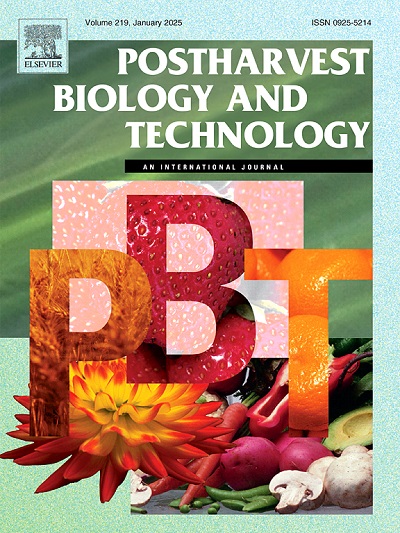Glycine betaine and MiWRKY53 enhance antioxidant capacity and disease resistance against Colletotrichum gloeosporioides in mango fruit
IF 6.4
1区 农林科学
Q1 AGRONOMY
引用次数: 0
Abstract
Mangoes, a quintessential tropical fruit, are highly susceptible to senescence and spoilage caused by Colletotrichum gloeosporioides during postharvest storage. Glycine betaine (GB), a natural compound with broad applications in the food industry, was investigated for its effects on the postharvest physiology, quality characteristics, and antioxidant activity of “Tainong No.1” mangoes. This study further elucidated the regulatory role of MiWRKY53 in the GB-mediated response. Results revealed that 10 mM GB treatment significantly suppressed the increase in the disease index while preserving titratable acidity (TA) and ascorbic acid (Vc) contents compared to the control (P < 0.05). GB treatment also reduced respiration rate, cell membrane permeability, and malondialdehyde (MDA) content, maintaining fruit firmness and delaying softening during storage. Moreover, GB treatment enhanced the activities of antioxidant enzymes, including phenylalanine ammonia-lyase (PAL), 4-coumarate-CoA ligase (4CL), chalcone isomerase (CHI), and catalase (CAT), which promoted the accumulation of antioxidant compounds such as total phenols, flavonoids, and lignin. An in vivo assay further demonstrated that GB disrupted fungal mycelium structure and inhibited spore germination in wounded mango fruit. Furthermore, GB treatment significantly upregulated the transcription levels of key genes, including MiPAL, Mi4CL, MiCHI, and MiWRKY53. MiWRKY53 was identified as a WRKY transcription factor that shows close evolutionary similarity to Pistacia vera based on Neighbor-joining phylogenetic tree analysis. Functional assays revealed that transient overexpression of MiWRKY53 enhanced CHI activity, reduced disease lesions, and maintained green pigmentation in mango discs and tobacco leaves. Conversely, virus-induced gene silence (VIGS) of MiWRKY53 resulted in adverse effects. This study highlights the potential of 10 mM GB treatment to control postharvest diseases and extend the shelf life of mangoes. The findings provide practical insights into leveraging natural compounds and genetic regulation for improving postharvest mango fruit quality.
求助全文
约1分钟内获得全文
求助全文
来源期刊

Postharvest Biology and Technology
农林科学-农艺学
CiteScore
12.00
自引率
11.40%
发文量
309
审稿时长
38 days
期刊介绍:
The journal is devoted exclusively to the publication of original papers, review articles and frontiers articles on biological and technological postharvest research. This includes the areas of postharvest storage, treatments and underpinning mechanisms, quality evaluation, packaging, handling and distribution of fresh horticultural crops including fruit, vegetables, flowers and nuts, but excluding grains, seeds and forages.
Papers reporting novel insights from fundamental and interdisciplinary research will be particularly encouraged. These disciplines include systems biology, bioinformatics, entomology, plant physiology, plant pathology, (bio)chemistry, engineering, modelling, and technologies for nondestructive testing.
Manuscripts on fresh food crops that will be further processed after postharvest storage, or on food processes beyond refrigeration, packaging and minimal processing will not be considered.
 求助内容:
求助内容: 应助结果提醒方式:
应助结果提醒方式:


